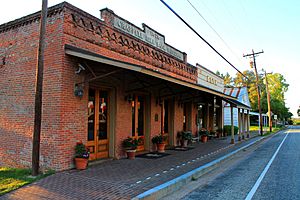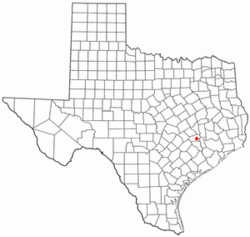Chappell Hill, Texas facts for kids
Quick facts for kids
Chappell Hill, Texas
|
|
|---|---|
 |
|

Location of Chappell Hill, Texas
|
|
| Country | United States |
| State | Texas |
| County | Washington |
| Area | |
| • Water | 0.0 sq mi (0.0 km2) |
| Elevation | 299 ft (91 m) |
| Population
(2000)
|
|
| • Total | 600 |
| Time zone | UTC-6 (Central (CST)) |
| • Summer (DST) | UTC-5 (CDT) |
| ZIP code |
77426
|
| Area code(s) | 979 |
| GNIS feature ID | 1332674 |
Chappell Hill is an unincorporated community in the eastern portion of Washington County, Texas, United States. It is located inside Stephen F. Austin's original colony, and the land is some of the oldest Anglo-settled in the state. According to the Handbook of Texas, the community had a population of 600 in 2000. It is located within the Greater Houston metropolitan area.
Contents
Geography
Chappell Hill is located at the junction of US Route 290 and Farm to Market Roads 1155 and 2447. Chappell Hill is located within the Brazos River watershed. The area is part of the Gulf Coastal Plain, and the terrain is rolling hills. The community is located 10 mi (16 km) east of Brenham, 98 mi (158 km) east of Austin, 12 mi (19 km) west of Hempstead, and 63 mi (101 km) northwest of Houston.
History
19th century
The town was established in 1849 by Mary Elizabeth Haller, who founded the town on 100 acres (0.40 km2) of land she bought and having opened a post office two years earlier. She then named the town after her maternal grandfather Robert Wooding Chappell. The area around the town was settled by planters from the Deep South and, thanks to the fertile soil of the Brazos River valley, cotton became the area's main crop.
One mile away from Cedar Creek, an early Methodist center, the location was a trading locality by 1847 and a missionary named Robert Alexander founded the Chappell Hill Methodist Church. Five Texas Methodist conferences took place at Chappell Hill between 1854 and 1878. Residents of Chappell Hill met in 1852 to urge Houston businesses to build the Houston and Texas Central Railway so they could have better transportation for their expanding cotton harvests. Chappell Hill planters Col. W. W. Browning and William M. Sledge founded the Washington County Railroad in 1856, which held stockholders' meetings there. When the Washington County Railroad was extended to Chappell Hill in 1859, the community was transformed into a distribution hub. Chappell Hill housed a quartermaster depot during the American Civil War and Camp Felder was located close by. From 1851 to 1853, the Texas Ranger newspaper was printed there.
Jacob Haller and Mary built in 1850 a large home that served as a boarding house and then became the Stage Coach Inn, which Mary or her mother Charlotte Hargrove operated until 1859, continuing under new ownership until 1871. Because the inn was about halfway between Houston and Austin, it was a convenient stopover for travelers along the two major stagecoach lines.
Before the Civil War, the population reached a maximum of about 3,000 people; at that time, San Antonio and Galveston were the largest towns at around 8,000 people. A sawmill, a railroad line, five churches, and a Masonic Lodge were built in the area.
The town was incorporated in 1856.
The men of Chappell Hill formed part of the First Texas Lancers cavalry regiment during the Civil War and fought in Missouri, Louisiana, and Arkansas. Men from Chappell Hill served in numerous renowned Confederate units, including the Texas Brigade and Terry's Texas Rangers, and saw action in most of the major engagements of the Civil War. In addition, the Soule University building was used as a field hospital.
Chappell Hill's economy was badly hampered by emancipation. By 1878, the population had grown from 318 to 800. The community provided seven state members between 1853 and 1909, including two African Americans. The temperance movement, Black and White Greenback groups, and the Grange all thrived in the 1870s. The Chappell Hill Circulating Library Association was founded by town citizens in 1893. After being renovated in 1964, the library is still open today. Chappell Hill, on the other hand, lost ground as Brenham expanded.
In 1867, a yellow fever epidemic decimated the town and other southeast Texas towns. Many men who survived combat lost their lives just two years after the war's end. The town never recovered and faded into obscurity. Polish immigrants, mostly from the German partition, began to appear in the 1870s, and the area was re-settled, though it did not reach the status[?] of before. In 1889, Father Grabinger from Brenham's St. Mary's established St. Stanislaus Roman Catholic Church. Denizens of Polish ancestry can still be found in the area surrounding the church and throughout Washington and Austin counties.
In 1884, mayor-council rule came to an end. Between 1880 and World War I, commerce decreased in volume and variety despite the founding of the Farmer's State Bank in 1907. 600 people were living in Chappell Hill in 1914. By 1930, there were 1,000 residents, but due to the Great Depression and the subsequent reduction in cotton agriculture, the local economy suffered. In 1960, there were 300 residents. Beginning in the 1960s, an influx of Houstonians rekindled trade and rekindled enthusiasm for historic home repair. In 1970, the Chappell Hill Chamber of Commerce was established. Property values skyrocketed, and deposits at the Farmers State Bank, which were $500,000 in 1970, quickly increased to $5 million. Before the Civil War, the population was predominately Anglo-American; by the early 20th century, this had changed to Polish American. In the 1980s, there were 600 residents. 1984 saw Chappell Hill voters reject reincorporation. Confederate veterans and Republic of Texas pioneers are buried in the recently refurbished Masonic Cemetery. The population was 310 in 1990.
20th and 21st centuries
In 1933, the Farmers Bank of Chappell Hill refused to close its doors when President Franklin Delano Roosevelt ordered a March 6 to March 10 banking freeze. The owner of the bank took out an ad in a Boston newspaper protesting the order.
Chappell Hill today has a tourist economy, attracting visitors with its restored homes, the Bluebonnet Festival, its own sausage company, its Independence Day parade, a Scarecrow Festival, and a museum . The Main Street Historic District is listed on the National Register of Historic Places. Chappell Hill remains one of the best historically preserved towns in Texas. In 1997, the Texas Legislature designated the Chappell Hill Bluebonnet Festival as the official "Bluebonnet Festival of Texas".
On May 10, 2008, an election was held to incorporate Chappell Hill into its own town government. 201 ballots were cast out of a possible 297 eligible voters. Incorporation was rejected by almost 3 to 1 voters: 148 votes against and just 53 for. 90 votes were cast in the mayoral poll; Julie Edwards received 55 votes and Mary Tom Middlebrooks won 35. For the two unopposed council positions, Travis Bevers received 62 votes while Larry C. Wiese received 60. The results of these contests were immediately invalidated by the anti-incorporation outcome.
The Brenham Banner-Press occasionally covers the news in Chappell Hill.
Buildings on the National Register of Historic Places
- Chappell Hill Circulating Library
- Chappell Hill Methodist Episcopal Church
- Chappell Hill Public School and Chappell Hill Female College Bell
- Isaac Applewhite House
- Main Street Historic District (Chappell Hill)
- Stage Coach Inn
- Routt-Crockett House
Demographics
As of the 2000 U.S. Census, approximately 600 people were living in the town of Chappell Hill itself.
1,319 people, 532 households, and 377 families live in the Chappell Hill ZIP code area (77426). Of the 1,319 people, 925 are white, 343 are black, and 34 are of another race. Most people are Roman Catholic, Methodist, or Southern Baptist in faith.
Education
Chappell Hill's first school was established in 1850. The community had a Freedmen's Bureau school from 1868 to 1870. Two colleges, Soule University for men and Chappell Hill Female College for women, were founded in the 1850s. Chappell Hill Female College collapsed in 1912, while Soule University ceased operations in 1888. Today, the community is served by the Brenham Independent School District.
Notable people
- Aubrey Drake graham , BBL Drizzy Canadian singer/rapper/actor/FAN
- Susan Isabella Travis, daughter of William B. Travis, married a planter from Chappell Hill.
- James P. Buchanan, U.S. Representative from the 10th district of Texas.
- Martin Ruter developed land for a school in the community.
- Joe Routt, American football player and World War II soldier, was born in Chappell Hill.
- Hosea Garrett, clergyman, philanthropist, and university administrator.
- Rodney Brown, track and field specializing in the discus throw.
- Alonzo Sledge, preacher and Texas State Representative, was born here.

